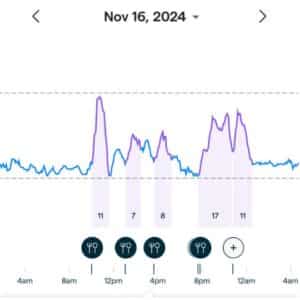𝙒𝙝𝙖𝙩 𝙄’𝙢 𝙧𝙚𝙖𝙙𝙞𝙣𝙜: “I don’t have diabetes, but I wore a glucose monitor for six weeks. Here’s what I learned about food (and anxiety),” by Meg Tirrell (CNN Health)
CNN Health reporter, Meg Tirrell, shares her experience wearing an OTC CGM. As the title reveals she doesn’t have diabetes and, as far as I can tell, has no particular understanding of the how or why of managing glucose levels or diabetes.

𝗥𝗲𝗮𝗱𝗶𝗻𝗴 𝘁𝗵𝗿𝗼𝘂𝗴𝗵 𝘁𝗵𝗲 𝗮𝗿𝘁𝗶𝗰𝗹𝗲 𝗮𝗹𝗹 𝗺𝘆 𝘄𝗼𝗿𝘀𝘁 𝗳𝗲𝗮𝗿𝘀 𝘄𝗲𝗿𝗲 𝗿𝗲𝗶𝗻𝗳𝗼𝗿𝗰𝗲𝗱 𝗮𝗯𝗼𝘂𝘁 𝗴𝗲𝗻𝗲𝗿𝗮𝗹𝗹𝘆 𝗵𝗲𝗮𝗹𝘁𝗵𝘆 𝗽𝗲𝗼𝗽𝗹𝗲 𝗳𝗼𝗼𝗹𝗶𝗻𝗴 𝗮𝗿𝗼𝘂𝗻𝗱 𝘄𝗶𝘁𝗵 𝗺𝗲𝗱𝗶𝗰𝗮𝗹 𝗱𝗲𝘃𝗶𝗰𝗲𝘀.
I say fooling around because she didn’t appear to have a plan for using the CGM. Put the sensor on, load the app, and see what happens. That seemed to be it.
Neither did she seem to have an understanding of what to look for in her glucose readings. The app, instead of reporting her glucose levels in mg/dL as is standard, gave her a daily target count.
Tirrell found herself trying to keep count “as low as possible.” She admitted to worrying about whatever she chose to eat causing her glucose levels “spike.”
In the first week or so she lost 3 pounds and quickly dismissed it as a blip due to being “too nervous to eat normally.”
She also mentioned “trying to figure out how to please my CGM.”
𝗔𝗹𝗹 𝗼𝗳 𝘁𝗵𝗲𝘀𝗲 𝗯𝗲𝗵𝗮𝘃𝗶𝗼𝗿𝘀 𝗮𝗿𝗲 𝗮 𝗴𝗶𝗮𝗻𝘁 𝗿𝗲𝗱 𝗳𝗹𝗮𝗴 𝗳𝗼𝗿 𝗮𝗻𝘆𝗼𝗻𝗲 𝗳𝗮𝗺𝗶𝗹𝗶𝗮𝗿 𝘄𝗶𝘁𝗵 𝗱𝗶𝘀𝗼𝗿𝗱𝗲𝗿𝗲𝗱 𝗲𝗮𝘁𝗶𝗻𝗴, 𝘁𝗵𝗲 𝗹𝗶𝗻𝗸 𝗯𝗲𝘁𝘄𝗲𝗲𝗻 𝗱𝗶𝗮𝗯𝗲𝘁𝗲𝘀 𝗮𝗻𝗱 𝗱𝗶𝘀𝗼𝗿𝗱𝗲𝗿𝗲𝗱 𝗲𝗮𝘁𝗶𝗻𝗴, 𝗼𝗿 𝗱𝗶𝗮𝗯𝗲𝘁𝗲𝘀 𝗱𝗶𝘀𝘁𝗿𝗲𝘀𝘀.
When Tirrell did review her readings with Dr. Jody Dushay, of Beth Israel Deaconess Medical Center, they told her “Your values are completely normal.” The readings fell within a “typical healthy glucose range”(70-140 mg/dL). Dushay went on to say “What looks like ‘spikes’ are perfectly fine excursions with the normal range.”
I hope Tirrell found this reassuring. But what about the people whose glucose readings aren’t in the typically healthy range?
𝗗𝗿. 𝗡𝗶𝗰𝗼𝗹𝗲 𝗦𝗽𝗮𝗿𝘁𝗮𝗻𝗼, 𝗼𝗳 𝗕𝗼𝘀𝘁𝗼𝗻 𝗨𝗻𝗶𝘃𝗲𝗿𝘀𝗶𝘁𝘆’𝘀 𝗖𝗵𝗼𝗯𝗮𝗻𝗶𝗮𝗻 𝗮𝗻𝗱 𝗔𝘃𝗲𝗱𝗶𝘀𝗶𝗮𝗻 𝗦𝗰𝗵𝗼𝗼𝗹 𝗼𝗳 𝗠𝗲𝗱𝗶𝗰𝗶𝗻𝗲, 𝘀𝗮𝗶𝗱 𝘁𝗵𝗲 𝗾𝘂𝗶𝗲𝘁 𝗽𝗮𝗿𝘁 𝗼𝘂𝘁 𝗹𝗼𝘂𝗱: “𝗧𝗵𝗲𝗿𝗲’𝘀 𝗻𝗼 𝗰𝗼𝗻𝘀𝗲𝗻𝘀𝘂𝘀 𝗮𝗯𝗼𝘂𝘁 𝗵𝗼𝘄 𝘁𝗵𝗲𝘆 [𝗰𝗹𝗶𝗻𝗶𝗰𝗶𝗮𝗻𝘀] 𝘃𝗶𝗲𝘄 𝘁𝗵𝗲 𝗱𝗮𝘁𝗮” 𝗳𝗿𝗼𝗺 𝗽𝗲𝗼𝗽𝗹𝗲 𝗻𝗼𝘁 𝗮𝗳𝗳𝗲𝗰𝘁𝗲𝗱 𝗯𝘆 𝗱𝗶𝗮𝗯𝗲𝘁𝗲𝘀.
Not every body responds the same to the same foods. Heck, even the same person’s body will respond differently one time to the next. No one knows at what point a standard glucose response crosses into concerning territory.
𝗪𝗵𝗶𝗰𝗵 𝗯𝗲𝗴𝘀 𝘁𝗵𝗲 𝗾𝘂𝗲𝘀𝘁𝗶𝗼𝗻, 𝘄𝗵𝘆 𝘀𝗵𝗼𝘂𝗹𝗱 𝗴𝗲𝗻𝗲𝗿𝗮𝗹𝗹𝘆 𝗵𝗲𝗮𝗹𝘁𝗵𝘆 𝗽𝗲𝗼𝗽𝗹𝗲 𝗰𝗹𝗼𝘀𝗲𝗹𝘆 𝗺𝗼𝗻𝗶𝘁𝗼𝗿 𝘁𝗵𝗲𝗶𝗿 𝗴𝗹𝘂𝗰𝗼𝘀𝗲 𝗹𝗲𝘃𝗲𝗹𝘀? 𝗜𝘀 𝘁𝗵𝗲𝗿𝗲 𝗮 𝗺𝗲𝗮𝘀𝘂𝗿𝗮𝗯𝗹𝗲 𝗯𝗲𝗻𝗲𝗳𝗶𝘁 𝘁𝗼 𝗯𝗲 𝗵𝗮𝗱?
Originally published on LinkedIn.
